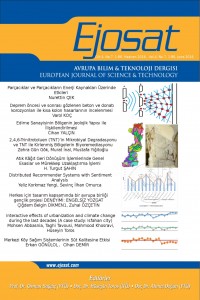Abstract
Project Number
4349-YL1-15
References
- Biermann, C.J. 1993. Essentials of Pulping and Papermaking, Academic Press, Inc. San
- Diego, USA.
- Brancato A. A. 2008. Effect of progresive recycling on cellulose fiber surface properties, Ph.D Theses, Georgia Institute of Tecnology, GA, USA 116 s.
- Broeren, L.A. 1991. New Technology, Economic Benefits Give Boost to Secondary
- Fiber Use, In: ‘Paper Recyling, Strategies, Economics, and Technology’, Ken L. Patrick, (Ed), Miller Freeman Inc., San Francisco, ABD, s. 65-70,
- Cathie, K., Guest, D. 1991. Waste Paper, Pira guide series, Antony Rowe Ltd, Chippenham, Wiltshire, England s.134.
- Clar, E.D., Hamilton, F.R., Kleinau, J.H. 1990. Economics of Secondary Fiber, In: ‘Secondary Fibers and Non wood Pulping’, M.J. Kocurek, (Series Editor), Tappi Press, Atlanta, GA. s.151-158
- Ellis, R.L. and Sedlachek, K.M. 1993. Recycled-versus virgin-fiber characteristic:a comparison. In : Secondary Fiber Recycling. Spangenberg, R.J. Ed. Tappi Press. Atlanta, Georgia.
- Kırcı, H. 2009. Kağıt Hamuru Endüstrisi Ders Notları, KTU Orman Fakültesi Yayınları, Trabzon.
- Kleinau, J.H. 1990a. Processes and Their Equipment, In: Secondary Fibers and Non wood Pulping, M.J. Kocurek, (Series Editor), Tappi Press, Atlanta, GA. s.159-178.
- Kleinau, J.H. 1990b. Contaminants, In: Secondary fibers and Non wood Pulping, M.J.
- Kocurek, (Series Editor), Tappi Press, Atlanta, GA. s.126-142.
- McCool, M. 1993. Flotation Deinking, In: Secondary Fiber Recyling, R.J. Spangenberg,
- (Editör), Tappi Press, Atlanta, GA. USA. s.141-162.
- Horacek, R.G. 1990. Washing Ink from the Pulp Slury In: Secondary Fibers and Non wood Pulping, M.J. Kocurek, (Series Editor), Tappi Press, Atlanta, GA. s.189-205.
- Horacek, R.G. 1993. Washing, In: Secondary Fiber Recyling, R.J. Spangenberg, (Editör), Tappi Press, Atlanta, GA. USA. S. 163-183.
- Orner, H.E. 1993. Flotatin Deinking, In: Secondary Fibers and Non wood Pulping, M.J. Kocurek (Series Editor), Tappi Press, Atlanta, GA. s.206-220.
- Reese, A. R. 1991. OCC Consumption Expected to Grow as Cost of Virgin Fiber Increases In: ‘Paper Recyling, Strategies, Economics, and Technology’, Ken L. Patrick, (Ed), Miller Freeman Inc., San Francisco, ABD, s.71-75.
- Spangenberg, R.J. 1993. Secondary Fiber Recyling, (Editor), Tappi Press, Atlanta, GA.
- Şahin, H.T. 2007. Kullanılmış Atık Kâğıtların Yeniden Kağıt Üretiminde Kullanılması, Orman Mühendisliği, 44 (7-9): 18-21.
- Şahin, H.T. 2009. Atık kağıt Özelliklerinin geri dönüşüme etkisi, Artvin Orman Fakültesi Dergisi, 10 (2): 117-123.
Abstract
Son yıllarda atık kağıtların geri dönüşümü üzerine çok yoğun çalışmalar yapılmıştır. Çalışmalarda, atık kâğıtların toplanarak selüloz hammaddesi olarak yeniden kağıt-karton ürünlerinin imalinde kullanılması üzerine (sekonder hamur) literatürde birçok olumlu görüş sunulmuştur. Kağıt geri dönüşüm üzerine geçmişte ve şimdiki düşünceler bazı farklılıklar göstermektedir. Eskiden geri dönüşüme, ekonomik ve ucuz hammadde sağlamak açısından bakılmıştır. Bu birçok bakımdan doğrudur. Fakat günümüzde ise çevresel faktörlerde atık kağıtların geri dönüşümünü zorlayıcı bir faktör olarak karşımıza çıkmaktadır.
Piyasada oluşan şartlar ve kağıt özellikleri incelendiğinde geri dönüşümde bazı potansiyel olumsuzluklarında göz önüne alınması gerektiği anlaşılmaktadır. Bu çalışmada literatür bilgileri ışığında atık kağıtların değerlendirilmesiyle elde edilebilecek olumlu faydaların yanında, muhtemel olarak oluşabilecek ve üzerinde fazla durulmayan bazı olumsuz durumlarda açıklanmıştır. Ayrıca, geri dönüşümde mürekkep uzaklaştırma işlemlerinde kullanılan teknolojik yaklaşımlarda açıklanmıştır.
Supporting Institution
SDÜ-BAP
Project Number
4349-YL1-15
Thanks
Yazar, sağladığı mali destek için (Proje no: 4349-YL1-15) SDÜ-BAP Koordinasyon Birimi’ne teşekkür etmektedir.
References
- Biermann, C.J. 1993. Essentials of Pulping and Papermaking, Academic Press, Inc. San
- Diego, USA.
- Brancato A. A. 2008. Effect of progresive recycling on cellulose fiber surface properties, Ph.D Theses, Georgia Institute of Tecnology, GA, USA 116 s.
- Broeren, L.A. 1991. New Technology, Economic Benefits Give Boost to Secondary
- Fiber Use, In: ‘Paper Recyling, Strategies, Economics, and Technology’, Ken L. Patrick, (Ed), Miller Freeman Inc., San Francisco, ABD, s. 65-70,
- Cathie, K., Guest, D. 1991. Waste Paper, Pira guide series, Antony Rowe Ltd, Chippenham, Wiltshire, England s.134.
- Clar, E.D., Hamilton, F.R., Kleinau, J.H. 1990. Economics of Secondary Fiber, In: ‘Secondary Fibers and Non wood Pulping’, M.J. Kocurek, (Series Editor), Tappi Press, Atlanta, GA. s.151-158
- Ellis, R.L. and Sedlachek, K.M. 1993. Recycled-versus virgin-fiber characteristic:a comparison. In : Secondary Fiber Recycling. Spangenberg, R.J. Ed. Tappi Press. Atlanta, Georgia.
- Kırcı, H. 2009. Kağıt Hamuru Endüstrisi Ders Notları, KTU Orman Fakültesi Yayınları, Trabzon.
- Kleinau, J.H. 1990a. Processes and Their Equipment, In: Secondary Fibers and Non wood Pulping, M.J. Kocurek, (Series Editor), Tappi Press, Atlanta, GA. s.159-178.
- Kleinau, J.H. 1990b. Contaminants, In: Secondary fibers and Non wood Pulping, M.J.
- Kocurek, (Series Editor), Tappi Press, Atlanta, GA. s.126-142.
- McCool, M. 1993. Flotation Deinking, In: Secondary Fiber Recyling, R.J. Spangenberg,
- (Editör), Tappi Press, Atlanta, GA. USA. s.141-162.
- Horacek, R.G. 1990. Washing Ink from the Pulp Slury In: Secondary Fibers and Non wood Pulping, M.J. Kocurek, (Series Editor), Tappi Press, Atlanta, GA. s.189-205.
- Horacek, R.G. 1993. Washing, In: Secondary Fiber Recyling, R.J. Spangenberg, (Editör), Tappi Press, Atlanta, GA. USA. S. 163-183.
- Orner, H.E. 1993. Flotatin Deinking, In: Secondary Fibers and Non wood Pulping, M.J. Kocurek (Series Editor), Tappi Press, Atlanta, GA. s.206-220.
- Reese, A. R. 1991. OCC Consumption Expected to Grow as Cost of Virgin Fiber Increases In: ‘Paper Recyling, Strategies, Economics, and Technology’, Ken L. Patrick, (Ed), Miller Freeman Inc., San Francisco, ABD, s.71-75.
- Spangenberg, R.J. 1993. Secondary Fiber Recyling, (Editor), Tappi Press, Atlanta, GA.
- Şahin, H.T. 2007. Kullanılmış Atık Kâğıtların Yeniden Kağıt Üretiminde Kullanılması, Orman Mühendisliği, 44 (7-9): 18-21.
- Şahin, H.T. 2009. Atık kağıt Özelliklerinin geri dönüşüme etkisi, Artvin Orman Fakültesi Dergisi, 10 (2): 117-123.
Details
| Primary Language | Turkish |
|---|---|
| Subjects | Engineering |
| Journal Section | Articles |
| Authors | |
| Project Number | 4349-YL1-15 |
| Publication Date | June 3, 2016 |
| Published in Issue | Year 2016 Volume: 4 Issue: 7 |

